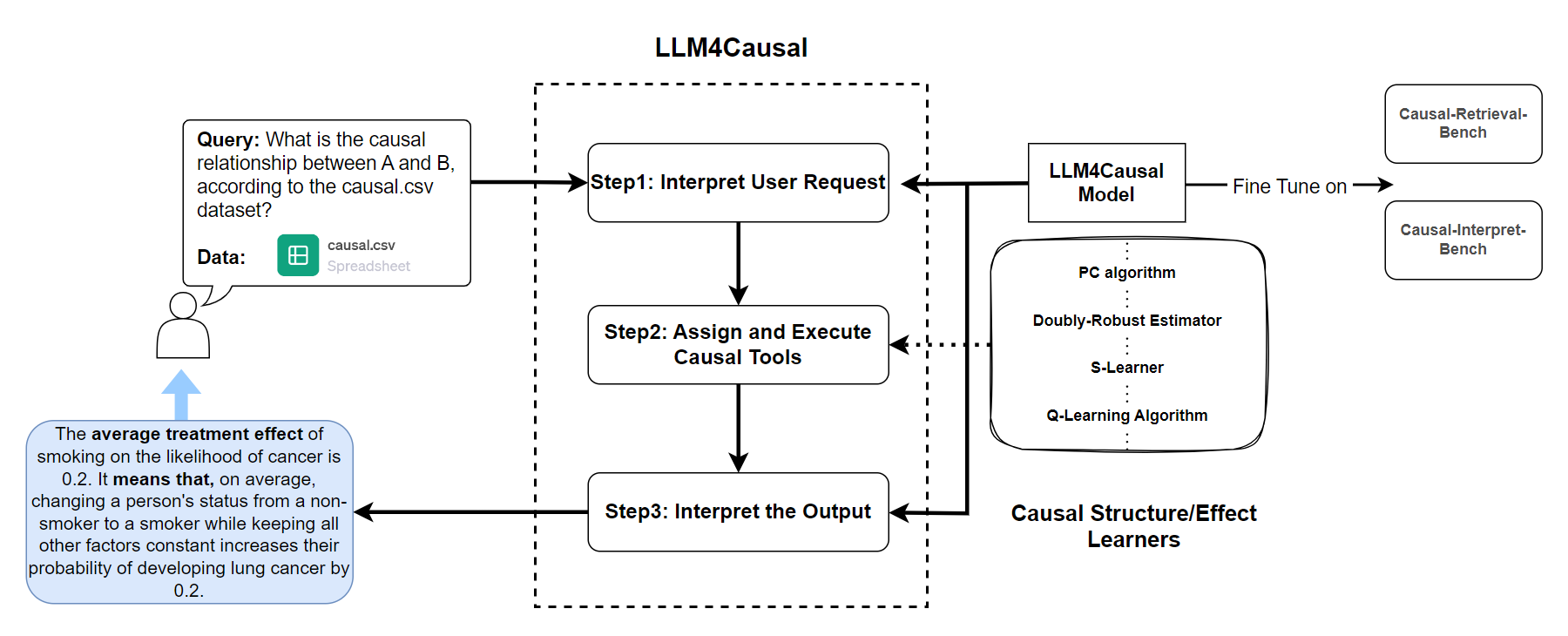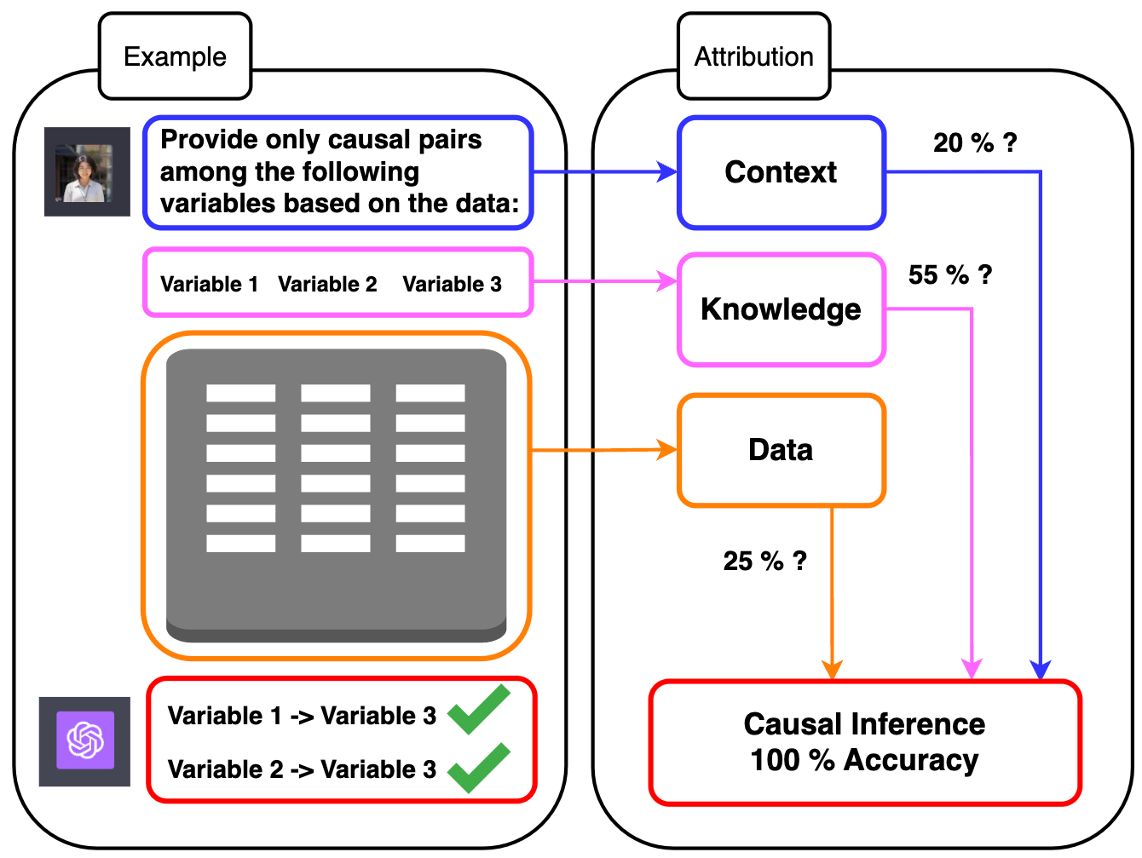Large Language Models are Effective Priors for Causal Graph Discovery
2405.13551

0
0
💬
Abstract
Causal structure discovery from observations can be improved by integrating background knowledge provided by an expert to reduce the hypothesis space. Recently, Large Language Models (LLMs) have begun to be considered as sources of prior information given the low cost of querying them relative to a human expert. In this work, firstly, we propose a set of metrics for assessing LLM judgments for causal graph discovery independently of the downstream algorithm. Secondly, we systematically study a set of prompting designs that allows the model to specify priors about the structure of the causal graph. Finally, we present a general methodology for the integration of LLM priors in graph discovery algorithms, finding that they help improve performance on common-sense benchmarks and especially when used for assessing edge directionality. Our work highlights the potential as well as the shortcomings of the use of LLMs in this problem space.
Create account to get full access
Overview
- This paper explores how incorporating background knowledge from Large Language Models (LLMs) can improve causal structure discovery from observational data.
- The researchers propose metrics for assessing the quality of LLM-provided priors for causal graph discovery.
- They systematically study different prompting techniques to enable LLMs to specify priors about causal graph structure.
- The paper presents a methodology for integrating LLM priors into graph discovery algorithms and shows these priors can improve performance, especially for assessing edge directionality.
- The work highlights both the potential and limitations of using LLMs for this problem.
Plain English Explanation
Causal relationships are important for understanding how the world works, but discovering these relationships from data can be challenging. Causal structure discovery from observations can be improved by integrating background knowledge. Recently, researchers have begun exploring Large Language Models (LLMs) as a source of this prior information, as querying them is relatively inexpensive compared to asking a human expert.
In this paper, the researchers first propose ways to assess how well the judgments from an LLM match the true causal structure, independent of the algorithm used for causal discovery. They then study different prompting strategies to allow the LLM to specify its beliefs about the causal relationships.
Finally, the researchers present a general method for incorporating the LLM's causal beliefs into graph discovery algorithms. They find that using the LLM's priors can improve performance, especially for determining the direction of causal relationships.
The work highlights both the potential and limitations of using LLMs for causal discovery. On the one hand, LLMs can provide useful prior information at low cost. But on the other hand, the researchers also identify shortcomings in the LLM's causal reasoning capabilities that need to be addressed.
Technical Explanation
The paper first proposes a set of metrics for assessing the quality of LLM-provided priors for causal graph discovery. These include measures of how well the LLM's beliefs match the true causal structure, as well as how informative the priors are for guiding the causal discovery process.
The researchers then systematically explore different prompting techniques to enable the LLM to specify its beliefs about causal graph structure. This includes prompts that ask the LLM to provide direct judgments about the presence and direction of causal relationships, as well as more open-ended prompts that allow the LLM to describe its causal understanding in natural language.
Finally, the paper presents a general methodology for integrating the LLM's causal priors into graph discovery algorithms. This involves transforming the LLM's natural language outputs into structured beliefs about the causal graph, which can then be used to guide the discovery process. The researchers find that using the LLM's priors can improve performance on common-sense benchmarks, especially for assessing the directionality of causal edges.
Critical Analysis
The paper makes a valuable contribution by systematically exploring the use of LLMs as a source of prior knowledge for causal discovery. The proposed metrics and prompting strategies provide a useful framework for assessing and leveraging LLM capabilities in this domain.
However, the researchers also identify important limitations in the LLM's causal reasoning abilities. For example, the LLM's judgments do not always align with the true causal structure, and it struggles with certain types of causal reasoning, such as distinguishing direct from indirect effects.
Additionally, the paper does not deeply explore the reasons behind these limitations. Further research is needed to better understand the causal cognition capabilities and shortcomings of LLMs, and how they can be improved to make them more reliable sources of causal knowledge.
The paper also does not address the potential biases or inconsistencies that may be present in the LLM's causal beliefs, which could be problematic if used to guide causal discovery. Careful validation and calibration of the LLM's priors may be necessary before incorporating them into real-world applications.
Overall, this paper is a valuable step forward in understanding the role of large language models in causal decision-making and integrating them with causal discovery algorithms. However, more research is needed to fully realize the potential of LLMs as sources of causal knowledge and to address their current limitations.
Conclusion
This paper explores the use of Large Language Models (LLMs) as a source of prior knowledge to improve causal structure discovery from observational data. The researchers propose metrics for assessing the quality of LLM-provided priors, study prompting techniques to elicit causal beliefs from LLMs, and present a methodology for integrating these priors into graph discovery algorithms.
The work highlights both the potential and limitations of LLMs for this problem. While LLMs can provide useful prior information at low cost, the paper also identifies shortcomings in the LLM's causal reasoning capabilities that need to be addressed. Further research is needed to better understand and improve the causal cognition of these large language models.
Overall, this paper represents an important step forward in leveraging the power of language models for graph-based machine learning and causal decision-making. As the field of evaluating the interventional reasoning capabilities of LLMs continues to evolve, this work highlights both the promise and the challenges in using LLMs as sources of causal knowledge.
This summary was produced with help from an AI and may contain inaccuracies - check out the links to read the original source documents!
Related Papers

Large Language Models for Constrained-Based Causal Discovery
Kai-Hendrik Cohrs, Gherardo Varando, Emiliano Diaz, Vasileios Sitokonstantinou, Gustau Camps-Valls

0
0
Causality is essential for understanding complex systems, such as the economy, the brain, and the climate. Constructing causal graphs often relies on either data-driven or expert-driven approaches, both fraught with challenges. The former methods, like the celebrated PC algorithm, face issues with data requirements and assumptions of causal sufficiency, while the latter demand substantial time and domain knowledge. This work explores the capabilities of Large Language Models (LLMs) as an alternative to domain experts for causal graph generation. We frame conditional independence queries as prompts to LLMs and employ the PC algorithm with the answers. The performance of the LLM-based conditional independence oracle on systems with known causal graphs shows a high degree of variability. We improve the performance through a proposed statistical-inspired voting schema that allows some control over false-positive and false-negative rates. Inspecting the chain-of-thought argumentation, we find causal reasoning to justify its answer to a probabilistic query. We show evidence that knowledge-based CIT could eventually become a complementary tool for data-driven causal discovery.
6/12/2024

Large Language Model for Causal Decision Making
Haitao Jiang, Lin Ge, Yuhe Gao, Jianian Wang, Rui Song

0
0
Large Language Models (LLMs) have shown their success in language understanding and reasoning on general topics. However, their capability to perform inference based on user-specified structured data and knowledge in corpus-rare concepts, such as causal decision-making is still limited. In this work, we explore the possibility of fine-tuning an open-sourced LLM into LLM4Causal, which can identify the causal task, execute a corresponding function, and interpret its numerical results based on users' queries and the provided dataset. Meanwhile, we propose a data generation process for more controllable GPT prompting and present two instruction-tuning datasets: (1) Causal-Retrieval-Bench for causal problem identification and input parameter extraction for causal function calling and (2) Causal-Interpret-Bench for in-context causal interpretation. By conducting end-to-end evaluations and two ablation studies, we showed that LLM4Causal can deliver end-to-end solutions for causal problems and provide easy-to-understand answers, which significantly outperforms the baselines.
4/15/2024

Causal Graph Discovery with Retrieval-Augmented Generation based Large Language Models
Yuzhe Zhang, Yipeng Zhang, Yidong Gan, Lina Yao, Chen Wang

0
0
Causal graph recovery is traditionally done using statistical estimation-based methods or based on individual's knowledge about variables of interests. They often suffer from data collection biases and limitations of individuals' knowledge. The advance of large language models (LLMs) provides opportunities to address these problems. We propose a novel method that leverages LLMs to deduce causal relationships in general causal graph recovery tasks. This method leverages knowledge compressed in LLMs and knowledge LLMs extracted from scientific publication database as well as experiment data about factors of interest to achieve this goal. Our method gives a prompting strategy to extract associational relationships among those factors and a mechanism to perform causality verification for these associations. Comparing to other LLM-based methods that directly instruct LLMs to do the highly complex causal reasoning, our method shows clear advantage on causal graph quality on benchmark datasets. More importantly, as causality among some factors may change as new research results emerge, our method show sensitivity to new evidence in the literature and can provide useful information for updating causal graphs accordingly.
6/19/2024

Is Knowledge All Large Language Models Needed for Causal Reasoning?
Hengrui Cai, Shengjie Liu, Rui Song

0
0
This paper explores the causal reasoning of large language models (LLMs) to enhance their interpretability and reliability in advancing artificial intelligence. Despite the proficiency of LLMs in a range of tasks, their potential for understanding causality requires further exploration. We propose a novel causal attribution model that utilizes ``do-operators for constructing counterfactual scenarios, allowing us to systematically quantify the influence of input numerical data and LLMs' pre-existing knowledge on their causal reasoning processes. Our newly developed experimental setup assesses LLMs' reliance on contextual information and inherent knowledge across various domains. Our evaluation reveals that LLMs' causal reasoning ability mainly depends on the context and domain-specific knowledge provided. In the absence of such knowledge, LLMs can still maintain a degree of causal reasoning using the available numerical data, albeit with limitations in the calculations. This motivates the proposed fine-tuned LLM for pairwise causal discovery, effectively leveraging both knowledge and numerical information.
6/6/2024